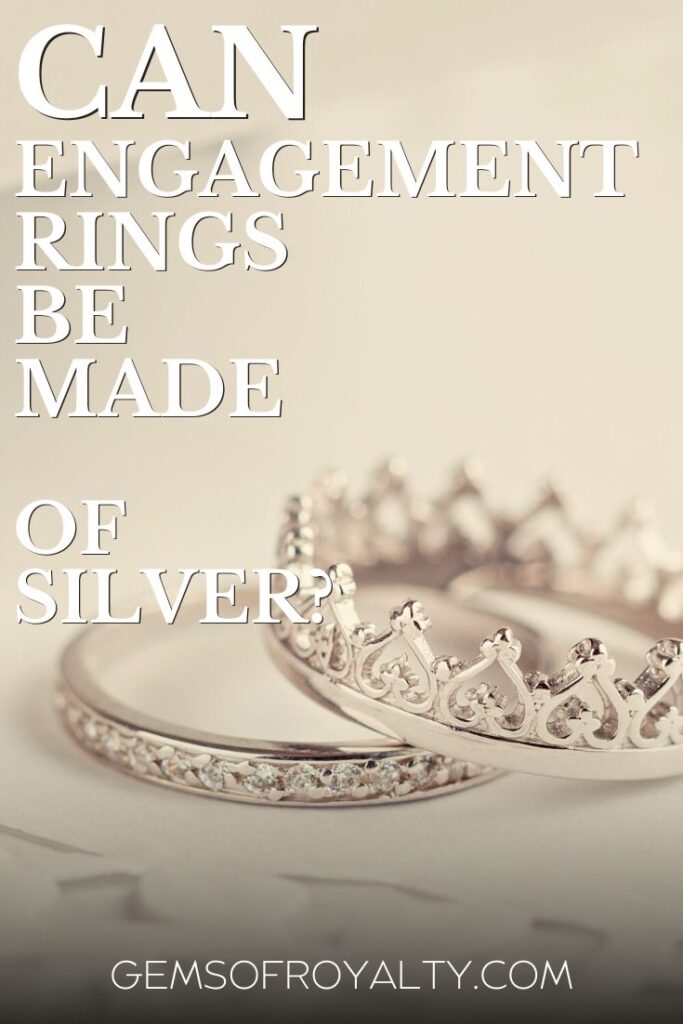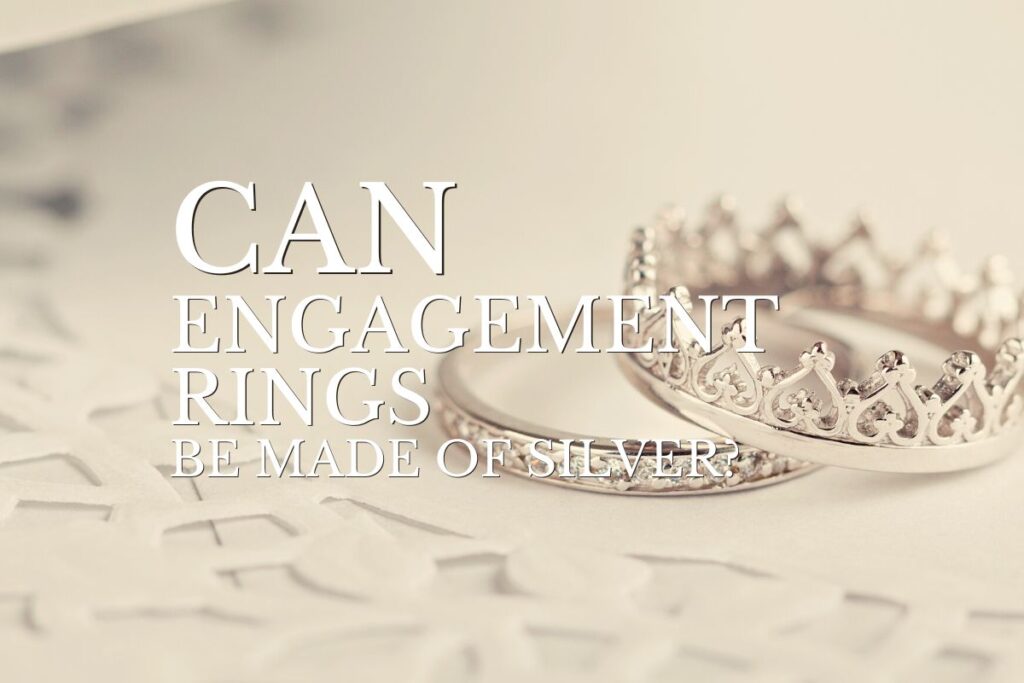Choosing an engagement ring is one of the most important decisions a couple makes together. Silver attracts many couples with its low price tag and bright, beautiful appearance. Between its reasonable cost and brilliant shine, is silver too good to be true?
Engagement rings can be made of silver. However, the metal is not a great option for any jewelry designed for everyday wear. Silver is soft and malleable, making it more susceptible to scratches, nicks, and scuffs.
This article explains why silver shouldn’t be your first choice for an engagement ring, offers guidance on caring for a silver engagement ring, and provides viable alternatives for the shining bands. Let’s dive right in.
Why Silver Engagement Rings Are Not the Best Choice
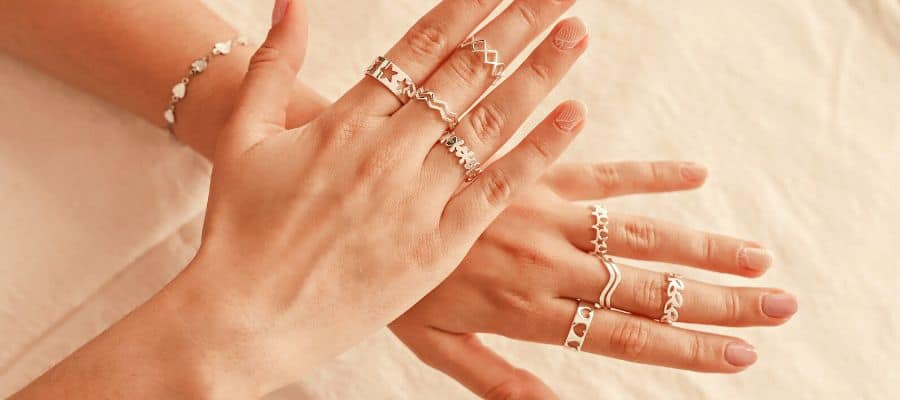
Silver is a beautiful alternative to the standard gold engagement ring. However, the metal is ill-suited to the everyday wear most engagement rings endure. In the sections below, I’ll explain why it’s not the most suitable precious metal type for an engagement ring:
Silver Is Easily Scratched and Damaged
Silver is a soft metal and can easily become damaged. It’s also not scratch-resistant, so your engagement ring won’t maintain its shine and pristine appearance over the years.
An engagement ring lives a long life and should be able to withstand the odd knock and scratch. Inevitably, it will rub against things that dull its surface. Silver doesn’t rebound from these interactions well, and its beauty gradually fades.
Silver Engagement Rings Require Special Maintenance
Because silver is a soft metal, it’s more challenging to clean than other precious metals, such as gold. The substance tarnishes and rusts easily, reacting poorly to moisture and oxidation.
Frequent cleanings are necessary to prevent this unsightly chemical reaction from ruining an engagement ring. Tarnish will not only impact your ring; it may affect the skin beneath it, discoloring it.
You should undertake cleaning silver carefully because harsh chemicals will further damage the silver and ruin the ring.
Silver Engagement Rings Can Lose Their Shape
An engagement ring suffers more daily abuse than we realize, and even flexing and unflexing our ring fingers stresses the metal. Silver rings lose their shape owing to the soft nature of the metal, and the bands buckle and bend under normal daily wear.
Silver’s softness makes it ill-equipped for holding stones. Most engagement rings include a diamond or other precious and expensive gem, and losing the rock would devastate a wearer. Standard wear and tear will certainly loosen the gem’s setting, requiring repair or even risking loss.
Silver Engagement Rings Cost More Over Time
Silver draws many ring buyers with its lower price point. While the metal is initially cheaper, it requires far more maintenance than other metals.
Because an engagement ring is intended to last a lifetime, it suffers more use and abuse, wearing down its beauty. Professional cleaning and repairs for silver engagement rings are expensive. Additionally, silver engagement rings must be redipped often to maintain their appearance.
How Long Do Silver Engagement Rings Last?
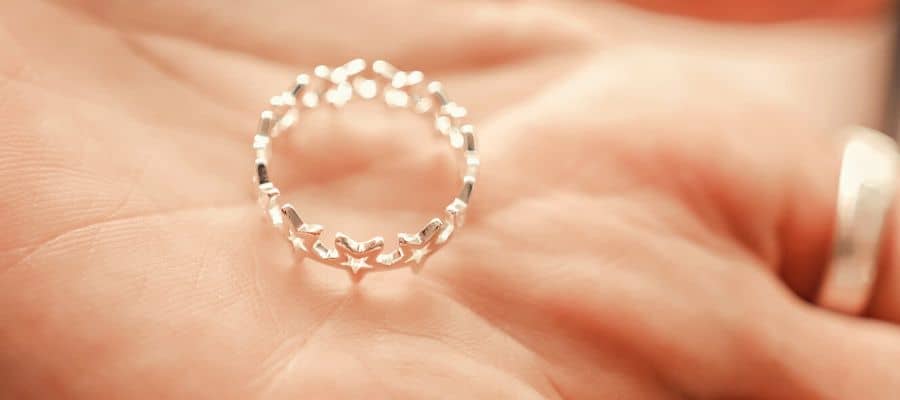
Ideally, you’ll wear your engagement ring for the rest of your life, and silver rings don’t have the same durability for daily wear as gold or platinum jewelry.
A sterling silver engagement ring typically lasts around 20 years of daily wear. Wearers need to care for the ring appropriately to achieve this lifespan, and this involves regular cleanings and polishing.
You can prolong a silver ring’s lifespan by only wearing it periodically; however, most people wear their engagement rings at all times.
When To Remove Your Silver Engagement Ring
Knowing when to remove your ring is essential to its longevity. While your engagement ring may feel like an extension of your hand, it’s a precious jewel ill-suited to certain day-to-day activities. Removing it at strategic times adds years to its life.
Take off your ring and store it somewhere secure during these times:
- While you’re cleaning. Cleaning often involves exposure to caustic chemicals. These substances damage your silver jewelry, even if you wear rubber gloves.
- While you’re exercising. It’s best to leave your silver engagement ring at home when you go to the gym or work out, so you don’t have to worry about it stored in a public locker room. Sweat threatens your ring in two ways; first, it makes your finger slick and increases the chances of it sliding off and getting lost. Second, the salt in perspiration discolors the metal.
- Doing dishes or laundry. Silver reacts poorly to chlorine, so you should remove your ring any time you may end up submerging your hand in the water.
- While you’re tanning. Or any time you spend extended time in direct sunlight. We may love soaking up the rays in the spring and summer, but prolonged solar exposure translates to tarnish on a silver ring.
- While you’re performing intense physical labor. Whether that means assembling a desk or chopping wood, silver is a soft metal. If you’re using your hands for anything that requires hard contact or frequent finger-flexing, the metal may become misshaped or even break.
- When you apply lotions or creams. You may be compelled to take your ring off to ensure maximum moisturization. Lotions and creams contain ingredients that damage the silver and make your finger and ring slippery.
Where To Store Your Silver Engagement Ring
Silver engagement rings need to be removed frequently, so it’s essential to have a safe place to stash it. A designated location always reminds you where you’ve stowed the engagement ring. Choose a dry place.
Resist the urge to simply slide the ornament off and leave it on the counter or soapdish while you do the dishes. However careful you strive to be, accidents happen, and the ring may go down the drain.
Dedicating extra time to bagging your ring in a ziplock bag or a soft fabric pouch is also wise. These protect your ring from oxidation, decreasing instances of tarnish and discoloration.
Choosing a Silver Band
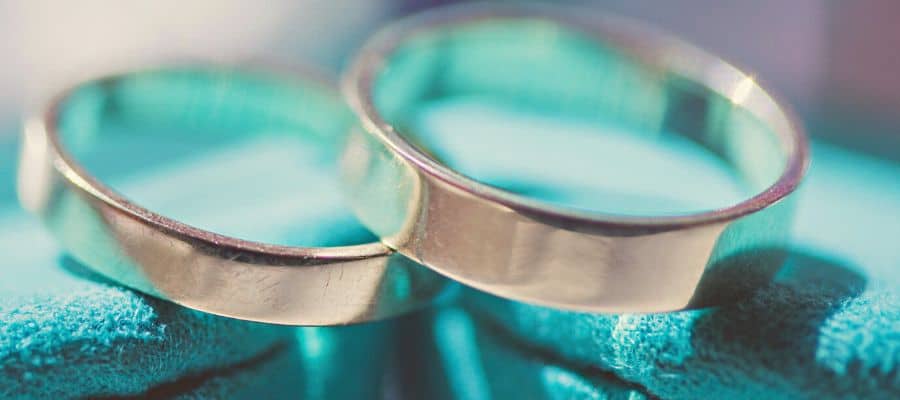
Fiancés committed to silver engagement rings need to consider whether they want their band engraved and what type of stone they purchase when choosing the band’s width.
Engraving or Embossing Your Silver Band
Engraving is a beautiful way to personalize an engagement ring. However, the process compromises the integrity of the metal. Silver is a soft, pliable substance without engraving.
Embossment is even worse; this process is deeper and more damaging to the metal. Beware of this personalization because it can cause even thicker bands to warp or break.
If you choose to have a silver engagement ring engraved, opt for a thicker band that can withstand the process. This option is best for a wearer who doesn’t use their hands for much high-contact work and is likely to be cognizant of their jewelry.
The Best Bands for Your Stones
Most engagement rings feature diamonds. However, some couples choose a different gem to express their love. Like metals, these stones have different densities. Never pair a soft rock with silver.
Maintaining a silver engagement ring requires polishing and cleaning, and these processes can damage softer gems.
However, the greatest consideration needs to be the size of the stone. Regardless of what gem you choose, excessively large ones will bend and potentially snap a thin silver band. Fiancés who opt for a large rock should select a thick silver band.
Caring for Silver Rings
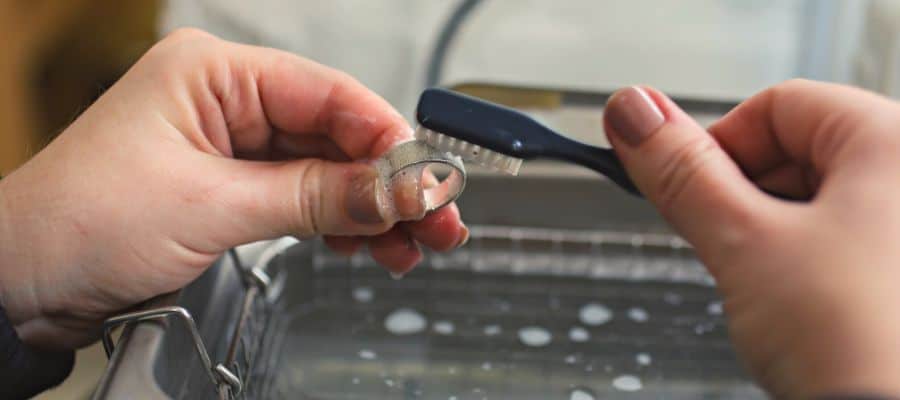
While gold and platinum rings are designed to endure everyday abuse, wear and tear damages, and discolors silver. Daily routines we all take for granted, like hand-washing or sanitizer application, impact the jewelry.
You could and should take the ring off every time you sanitize or wash your hands; however, that increases the odds of losing the band and requires memory.
Proper care is essential to silver’s longevity. Take silver jewelry off before showering, washing your hands, applying creams and lotions, or sanitizing. The metal reacts poorly to chemicals, so be sure to protect your ring from them.
Cleaning Your Silver Engagement Ring
Regular cleaning helps keep your silver engagement ring looking beautiful and sparkly. It is also essential to maintaining the integrity of the piece. However, silver is soft and incorrect cleaning can bend the ring or loosen the stone setting.
You may choose to leave it to the professionals. However, frequent jewelry cleaning becomes expensive when applied to a piece worn daily.
Fortunately, at-home cleaning methods will keep your silver engagement ring immaculate:
Warm Water and Dish Soap
Soap and water is a classic for a reason. The two simple cleaning ingredients keep your ring clean and shiny. Always use warm water with a dish detergent for delicate skin-remember that silver is fragile. Gently wipe the ring with the mixture, and don’t soak it. Soaking opens the door for rust and tarnish.
Water and Baking Soda Paste
- Combine warm water and baking soda into a spreadable paste.
- Cover the ring using a soft cloth or toothbrush-something gentle that won’t defeat your hard work by damaging the metal.
- Rinse the ring with warm water and gently but thoroughly dry it with a soft cloth.
Hot Water, Salt, and Baking Soda Bath
Use this method for a deeper and more thorough cleaning than soap and water can provide. It will be a little smelly, but don’t worry; that means it’s working.
- Start by lining a glass baking dish with aluminum foil, shiny side up.
- Put your silver engagement ring on the foil and cover it with boiling water.
- Make sure the ring is fully submerged.
- Add two tablespoons each of baking soda and salt and allow the ring to soak.
- Remove the jewelry after ten or fifteen minutes.
- Rinse, dry, and enjoy your deep-cleaned engagement ring.
Mixture of Olive Oil and Lemon Juice
Undoubtedly the most fragrant option on this list, the pairing of natural ingredients is gentle on your silver.
- Mix one teaspoon of olive oil into half a cup of lemon juice.
- Use a soft fabric to lightly apply the cleanser to your ring, then rinse and dry thoroughly.
Mixture of Baking Soda and White Vinegar
This is a more intense cleaning solution best reserved for a very rusted ring.
- Mix half a cup of vinegar with two tablespoons of baking soda. This creates a chemical reaction that eats away the rust.
- Soak your ring in the liquid for up to three hours for a thorough cleaning.
- Rinse the ornament thoroughly with warm water and dry it.
However, if you choose to clean your silver engagement ring, always be sure to dry it completely with a soft rag. Any remaining moisture feeds rust development and damages the integrity of your silver.
The Best Alternatives to Silver Engagement Rings
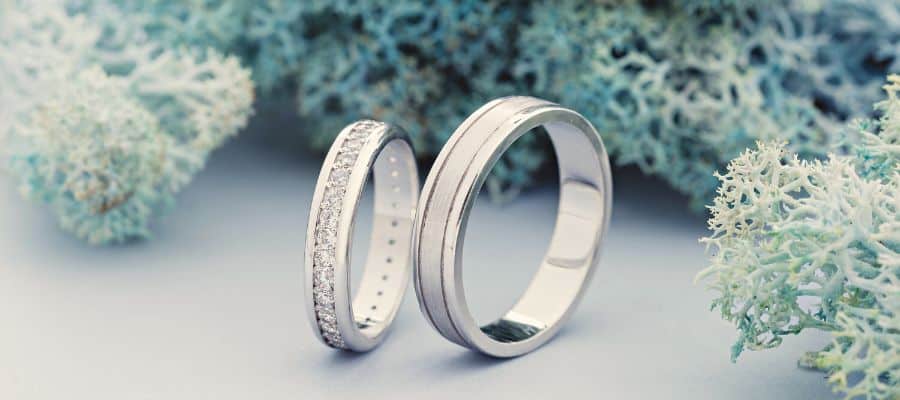
A silver engagement ring asks a lot of an owner. Even the most diligent wearer may tire of the upkeep and care. Additionally, some distortion and damage are beyond your control.
Fiancés who choose silver for its bright appearance have other options. While they require a larger initial investment, these metals won’t need the upkeep, cleaning, and resizing that silver rings do, which will save you money in the long run.
14K White Gold
14k white gold is higher maintenance than yellow gold but much easier to maintain than silver. The metal is always coated in rhodium, which protects it from nicks and scratches while helping preserve the ring’s shape.
14k white gold is a really bright and beautiful metal. The hue is very close to silver, so if color is your primary consideration, 14k white gold is certain to scratch that itch.
14k white gold engagement rings are well equipped to handle the daily abuse engagement rings endure. These rings are easily washed and cared for with soap and water.
At some point, you may need to have your engagement ring re-coated in rhodium. Additionally, fiancés with nickel allergies should avoid the metal.
Platinum
Platinum is undeniably a larger investment. The metal isn’t cheap; however, if you can swing it, the initial investment pays for itself by requiring very little care and upkeep as time progresses.
Platinum is a bright, beautiful, and hypoallergenic metal. If the intended wearer has sensitive skin, platinum is definitely the best ring choice.
Additionally, the metal is strong. Nicks and scratches won’t penetrate the surface, and you won’t need to worry about constantly removing the ring. The engagement band will retain its shape as you go about your daily routine, whether typing on a laptop or loading boxes onto a truck.
Conclusion
Engagement rings can be made of silver, but you should prepare to commit to thorough care.
The metal is soft and poorly suited to the everyday wear expected of an engagement ring. However, diligent wearers can maintain the jewelry with patience and care.
Be prepared to remove the ring frequently and clean it often to maintain the metal’s optimal luster. However, investing in an initially more costly metal will save you stress and expense over time.
If you found this article useful, make sure you save this pin below to your Jewelry board.
